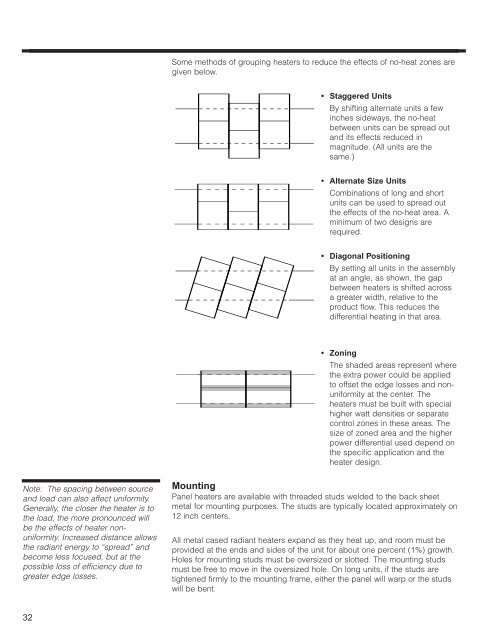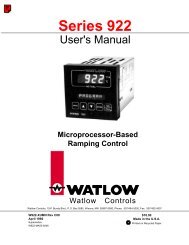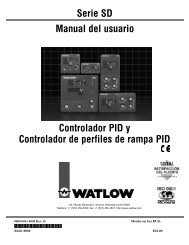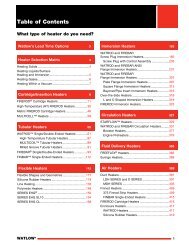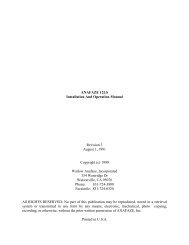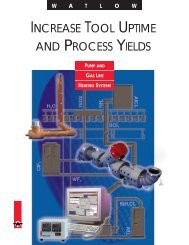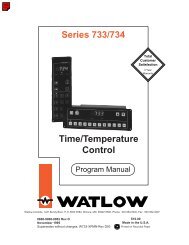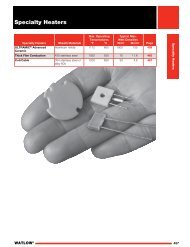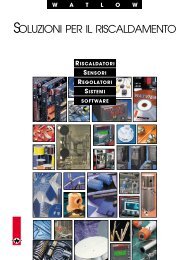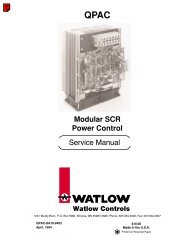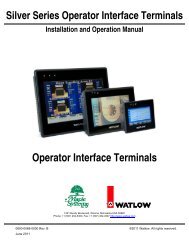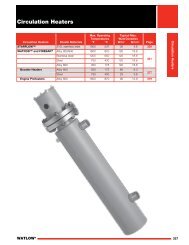RADIANT HEATING WITH INFRARED - Watlow
RADIANT HEATING WITH INFRARED - Watlow
RADIANT HEATING WITH INFRARED - Watlow
You also want an ePaper? Increase the reach of your titles
YUMPU automatically turns print PDFs into web optimized ePapers that Google loves.
Note: The spacing between source<br />
and load can also affect uniformity.<br />
Generally, the closer the heater is to<br />
the load, the more pronounced will<br />
be the effects of heater nonuniformity.<br />
Increased distance allows<br />
the radiant energy to “spread” and<br />
become less focused, but at the<br />
possible loss of efficiency due to<br />
greater edge losses.<br />
32<br />
Some methods of grouping heaters to reduce the effects of no-heat zones are<br />
given below.<br />
• Staggered Units<br />
By shifting alternate units a few<br />
inches sideways, the no-heat<br />
between units can be spread out<br />
and its effects reduced in<br />
magnitude. (All units are the<br />
same.)<br />
• Alternate Size Units<br />
Combinations of long and short<br />
units can be used to spread out<br />
the effects of the no-heat area. A<br />
minimum of two designs are<br />
required.<br />
• Diagonal Positioning<br />
By setting all units in the assembly<br />
at an angle, as shown, the gap<br />
between heaters is shifted across<br />
a greater width, relative to the<br />
product flow. This reduces the<br />
differential heating in that area.<br />
• Zoning<br />
The shaded areas represent where<br />
the extra power could be applied<br />
to offset the edge losses and nonuniformity<br />
at the center. The<br />
heaters must be built with special<br />
higher watt densities or separate<br />
control zones in these areas. The<br />
size of zoned area and the higher<br />
power differential used depend on<br />
the specific application and the<br />
heater design.<br />
Mounting<br />
Panel heaters are available with threaded studs welded to the back sheet<br />
metal for mounting purposes. The studs are typically located approximately on<br />
12 inch centers.<br />
All metal cased radiant heaters expand as they heat up, and room must be<br />
provided at the ends and sides of the unit for about one percent (1%) growth.<br />
Holes for mounting studs must be oversized or slotted. The mounting studs<br />
must be free to move in the oversized hole. On long units, if the studs are<br />
tightened firmly to the mounting frame, either the panel will warp or the studs<br />
will be bent.


